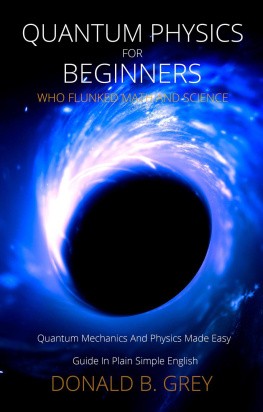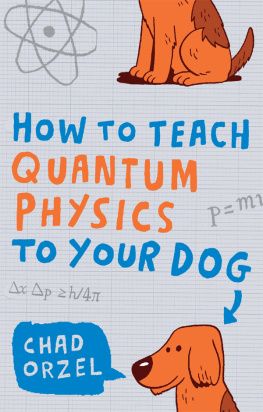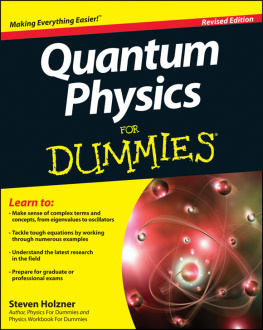Quantum Physics and The Power of the Mind
Discover all the important features of Quantum Physics and the Law of Attraction, find out how it really works to change your life for the better.
Nancy Patterson
TABLE OF CONTENTS
Introduction
Quantum mechanics, commonly called quantum physics, is the relationship between energy and matter. The word quantum is Latin for how much. Mechanics refers to a unit in which quantum theory assigns to specific physical quantities in minimal quantities as a measure. In essence, quantum expressions are generally visualized and studied sub atomically with subatomic particles. Subatomic particles are small. If an atom were the size of a house, the subatomic molecule would be the size of a drop of chewing gum in the kitchen cabinet of that house.
There were a few things that needed to occur before the investigation of quantum mechanics flourished. In 1838 was the disclosure of cathode beams and Gustav Kirchhoff published a statement in 1850 on the problem of blackbody radiation. So, in 1877, Ludwig Boltzmann proposed that the energetic states of a physical system could be unconnected.
In 1900 Max Planck developed the theory that energy is radiated and absorbed. He made an equation known as Planck's activity consistent. Planck is known as the grandad of quantum material science. After his theory was circulated, other scientists took note of it and discovered other theoretical structures until, eventually, quantum mechanics was theorized and studied around the world. Because of quantum physics, we discovered gravity, we have superconductors and magnetic resonance imaging equipment in hospitals, and now we can even see that time travel is possible.
It all sounds so fantastic, but scientists in the field of quantum mechanics will tell you. It is hard for a most of us to comprehend the connection between subatomic particles and the law of attraction. During the investigation of quantum mechanics, it was discovered that subatomic particles determine the direction that the earth is turning. Another force moves these particles of physical matter out into the universe. After some double-blind slit tests using subatomic particles as subjects, it was discovered that they could switch between wave-shaped particles and then back to block shaped particles again. These particles could leave our dimension and enter it again. We also found that these subatomic particles changed deliberately from wave-shaped particles depending on the purpose. So, we found out that when we were testing the particles, we could not remove ourselves from the equation. We influenced the particles by thinking about the result. This is where it becomes confusing and the concept confused Einstein until his death. Understanding particle and wave duality is not easy for most of us to comprehend.
However, one of the theories that emerged from the foundations of quantum physics is that we manipulate the fabric of life by thinking about it. Our thoughts have an expression that comes out and therefore brings us to what we focus on so that it is a reality. This is the law of attraction. Every single quantum physicist will agree on one thing. The subatomic particles, the energy packets or quantum, are not particles at a certain point in space and time like a table or a chair, but they are just a probability that they could exist at different points in space and time.
The act of our observation converts it into a physical particle at a certain point in space and time. Once we withdraw that attention, it becomes a probability again. Imagine that the sofa in your living room is a sizeable subatomic particle. This is how it would behave: If you are not in the house and do not think of your sofa, it would disappear and become a probability that it could reappear anywhere in your living room or anywhere else in the universe! If you come home thinking about sitting on the sofa in a specific place in your living room and looking for the sofa where you want to relax, it reappears! This seems like a kind of fantasy, but it is a scientific fact that subatomic particles behave in the same way.
The presence of your sofa is only the result of you seeing it, expecting it, and deciding that it is there. It is not a completely independent existence. No matter is an entirely separate existence, regardless of the observer. The astonishing thing is that all matter consists only of large amounts of these particles. Therefore, all matter behaves precisely as a large group of subatomic particles would.
Quantum physics confirms that a thing can only exist if it is observed. The 'quanta' is organized according to the influence of the mind principle of the observers. When something is observed, quanta merge into subatomic particles and then into atoms, followed by molecules, until finally, something in the physical world manifests itself as a localized temporal space-time experience that can be perceived through the mediation of our five physical senses, then lead to something that appears to be reliable and is part of what people usually understand as physical reality.
An experiment by modern quantum physicists shows and proves that the entire universe exists through experience. The most fantastic research in quantum physics in recent scientific discovery is probably the double-slit experiment. Every single thought, as energy, directly and instantly influences the quantum field, whereby 'Quanta' merges into a localized, observable experience event, object, or other influence. This process is the basis for how everyone creates their reality.
Those who understand and comply with universal laws are conscious creators, while others create their life experience by default. As a result, they attribute everything that has been experienced as being a consequence of their unconscious thinking to superstitious beliefs such as luck, fate, chance, and fortune. We know that conscious creation is also the basis of the law of attraction and the law of cause and effect!
Max Planck the Father of Quantum Theory
All objects emit electromagnetic radiation, which is called heat radiation. But we only see them when the objects are very hot. Because then they also emit visible light. Like glowing iron or our sun. Of course, physicists were looking for a formula that would correctly describe the emission of electromagnetic radiation. But it just did not work out. Then, in 1900, the German physicist Max Planck (1858 - 1947) took a courageous step.
The emission of electromagnetic radiation means the emission of energy. According to the Maxwell equations, this energy release should take place continuously. "Continuously" means that any value is possible for the energy output. Max Planck now assumed that the energy output could only take place in multiples of energy packets, i.e., in steps. That led him to the correct formula. To the energy packets, Planck said, "quanta." Therefore, the year 1900 is regarded as the year of birth of quantum theory.
Important: Only the emission (and the absorption) of the electromagnetic radiation should occur in the form of quanta. Planck did not assume that it was composed of quanta. Because that would mean that it would have a particle character. However, like all other physicists of his time, he was persuaded that electromagnetic radiation comprised absolutely of waves. Young's double-slit experiment has revealed it, and the Maxwell equations have established it.






